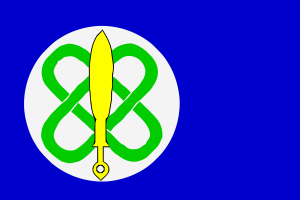Language/Yoruba/Vocabulary/Shapes
| ◀️ Colors — Previous Lesson | Next Lesson — Traditional Festivals ▶️ |
Introduction[edit | edit source]
Welcome to the Yoruba Vocabulary lesson on shapes! In this lesson, you will learn the names of basic shapes in Yoruba and how to use them to describe objects and their characteristics. Understanding shapes is an important part of building your Yoruba vocabulary and being able to communicate effectively in the language. By the end of this lesson, you will be able to confidently identify and describe various shapes in Yoruba.
Basic Shapes[edit | edit source]
Let's start by learning the names of the basic shapes in Yoruba. Here are some of the most common shapes and their corresponding names in Yoruba:
| Yoruba | Pronunciation | English Translation |
|---|---|---|
| Ogo | OH-goh | Circle |
| Onka | OHN-kah | Square |
| Ogun | OH-goon | Triangle |
| Ifa | EE-fah | Rectangle |
| Igun | EE-goon | Oval |
| Iru | EE-roo | Diamond |
| Apoti | AH-poh-tee | Cylinder |
| Ase | AH-say | Cube |
| Aro | AH-roh | Cone |
| Ipa | EE-pah | Hemisphere |
| Ije | EE-jay | Sphere |
| Opin | OH-peen | Pyramid |
| Ikorira | EE-koh-ree-rah | Pentagon |
| Ehin | EH-heen | Hexagon |
| Isan | EE-sahn | Octagon |
Take your time to practice pronouncing each shape in Yoruba. Pay attention to the nuances of the Yoruba language and try to replicate the sounds as accurately as possible. This will not only help you improve your pronunciation but also deepen your understanding of the Yoruba culture and language.
Describing Objects[edit | edit source]
Now that you know the names of the basic shapes in Yoruba, let's learn how to use them to describe objects and their characteristics. In Yoruba, you can use the word "ni" to indicate possession or association. For example:
- "Onka ni aya mi" means "My house is square." - "Ogo ni ounje mi" means "My food is circular." - "Igun ni ibeji mi" means "My twin's head is oval."
In these examples, we are using the shapes to describe different objects and their properties. This is a common practice in Yoruba, where shapes are often used to convey specific meanings or characteristics.
Let's practice describing objects using shapes in Yoruba. Look at the following objects and try to describe them using the appropriate shape vocabulary:
1. A clock - "Aro ni awon" (It is a cone) 2. An orange - "Ogo ni odan" (It is circular) 3. A book - "Onka ni iwe" (It is square) 4. A door - "Ifa ni irin" (It is rectangular) 5. A soccer ball - "Igun ni olu" (It is oval)
Remember to use the correct shape vocabulary and the word "ni" to indicate possession or association. Take your time to practice describing different objects using shapes in Yoruba. It will greatly enhance your language skills and understanding of the Yoruba culture.
Cultural Significance[edit | edit source]
Shapes have a cultural significance in Yoruba tradition and art. They are often used to represent different concepts and ideas. For example, the circle (ogo) is a symbol of unity and continuity in Yoruba culture. It is often used to represent the interconnectedness of life and the cyclical nature of the universe. The square (onka) is associated with stability and balance, while the triangle (ogun) is often used to represent strength and power.
In Yoruba art, shapes are used to create intricate patterns and designs. Adire, a traditional Yoruba textile art, often features geometric shapes that are both aesthetically pleasing and meaningful. These shapes are carefully chosen to convey specific messages or tell stories. The use of shapes in Yoruba art reflects the rich cultural heritage and creativity of the Yoruba people.
Exercises[edit | edit source]
Now it's time to test your knowledge and practice using shapes in Yoruba. Complete the following exercises and check your answers at the end.
Exercise 1: Match the Yoruba shape vocabulary with their corresponding English translations.
Answer: 1. B, 2. A, 3. C, 4. D, 5. E Exercise 2: Describe the following objects using the appropriate shape vocabulary. 1. A cup - "Ipa ni ibi naa" (It is a hemisphere) 2. A tree - "Ije ni ibi naa" (It is a sphere) 3. A pyramid - "Opin ni ibi naa" (It is a pyramid) 4. A kite - "Ikorira ni ibi naa" (It is a pentagon) 5. A stop sign - "Ehin ni ibi naa" (It is a hexagon) Now, let's check your answers! Exercise 1: Answers - 1. B, 2. A, 3. C, 4. D, 5. E Exercise 2: Answers - 1. Ipa, 2. Ije, 3. Opin, 4. Ikorira, 5. Ehin Congratulations on completing the exercises! You're making great progress in learning Yoruba.Conclusion[edit | edit source]
In this lesson, you have learned the names of basic shapes in Yoruba and how to use them to describe objects and their characteristics. Shapes play an important role in the Yoruba language and culture, and understanding them will greatly enhance your language skills and cultural knowledge. Keep practicing and exploring the rich world of Yoruba shapes, and you'll be well on your way to becoming fluent in Yoruba.
Sources[edit | edit source]
Other Lessons[edit | edit source]
- Animals
- Common Foods
- Days of the Week
- Drinks
- Clothes
- How to say Good Bye?
- Introducing Yourself and Others
- Feelings and Emotions
- Express Surprise
- Health
| Yoruba | English Translation |
|---|---|
| Ogo | A. Square |
| Onka | B. Circle |
| Ogun | C. Triangle |
| Ifa | D. Rectangle |
| Igun | E. Oval |
| ◀️ Colors — Previous Lesson | Next Lesson — Traditional Festivals ▶️ |

